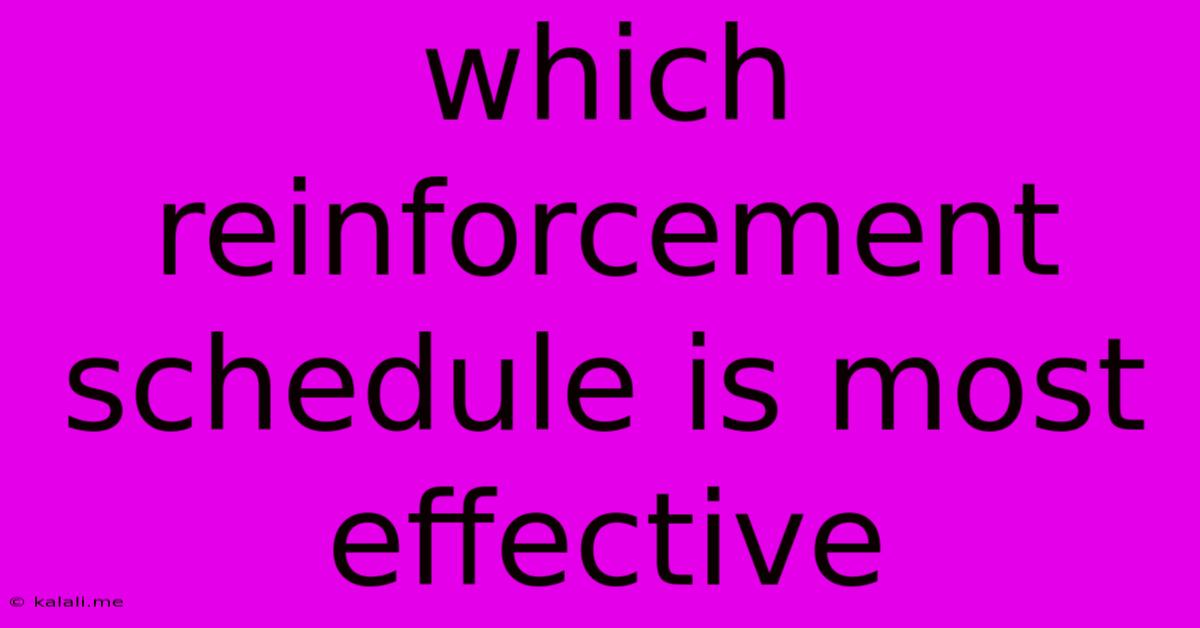Which Reinforcement Schedule Is Most Effective
Kalali
Jun 15, 2025 · 3 min read

Table of Contents
Which Reinforcement Schedule is Most Effective? A Deep Dive into Motivation and Behavior
Choosing the right reinforcement schedule is crucial for achieving lasting behavioral change, whether you're training a pet, managing employee performance, or working on personal habits. This article explores various reinforcement schedules, comparing their effectiveness in different contexts, and helping you determine which one best suits your needs. Understanding the nuances of these schedules can significantly impact your success.
What are Reinforcement Schedules?
Reinforcement schedules dictate when and how often a reward or consequence is delivered following a desired behavior. They are categorized into two main types: continuous and intermittent.
-
Continuous Reinforcement: Every instance of the desired behavior is rewarded immediately. This is excellent for initial learning but can lead to rapid extinction if rewards cease.
-
Intermittent Reinforcement: Rewards are given inconsistently, making the behavior more resistant to extinction. This is the more effective approach for long-term maintenance of learned behaviors. Intermittent schedules are further divided into:
Types of Intermittent Reinforcement Schedules:
1. Ratio Schedules (based on the number of responses):
-
Fixed-Ratio (FR): Reinforcement is delivered after a fixed number of responses. For example, rewarding a rat with food after every 5 lever presses. This often leads to a "post-reinforcement pause," where behavior slows after receiving the reward. Think of a factory worker getting paid after completing a specific number of items.
-
Variable-Ratio (VR): Reinforcement is delivered after a variable number of responses, with the average number remaining constant. For instance, rewarding a rat with food after an average of 5 lever presses, but sometimes after 2, sometimes after 8. This schedule produces a high, steady rate of responding, as the unpredictability keeps the subject engaged. Slot machines operate on this principle, leading to persistent gambling behavior.
2. Interval Schedules (based on the passage of time):
-
Fixed-Interval (FI): Reinforcement is delivered after a fixed time interval, provided at least one response has occurred. Think of a weekly paycheck – you're rewarded after a set period, regardless of the number of hours worked during that week. This often results in a scalloped pattern of responding, with increased activity closer to the reward time.
-
Variable-Interval (VI): Reinforcement is delivered after a variable time interval, with the average interval remaining constant. This schedule produces a slow, but steady rate of responding because the subject never knows precisely when the reward will arrive. Checking email is a good example; you check intermittently, and sometimes find new messages, other times you don't.
Which Schedule is Most Effective?
The "most effective" reinforcement schedule depends entirely on your goals and the specific context.
-
For initial learning and rapid acquisition of a new behavior: Continuous reinforcement is the most efficient.
-
For maintaining a behavior long-term and making it resistant to extinction: Variable-ratio (VR) schedules are generally considered the most effective. The unpredictable nature of rewards keeps motivation high and prevents rapid extinction.
-
For consistent, though perhaps not the highest-rate, behavior: Variable-interval (VI) schedules are a good option. They promote steady responding without the bursts and pauses seen in other schedules.
Considerations beyond Schedule Selection:
- The nature of the reward: The reward itself must be motivating and valuable to the individual.
- The individual's learning history: Previous experiences can influence the effectiveness of different schedules.
- The overall learning environment: A supportive and positive environment enhances learning regardless of the chosen schedule.
Ultimately, experimentation and observation are key. Understanding the principles behind different reinforcement schedules allows for informed decision-making and maximizes the chances of successfully shaping desired behaviors. By carefully considering the context and desired outcome, you can select the most appropriate reinforcement schedule to achieve your goals effectively.
Latest Posts
Latest Posts
-
Which Of The Following Sentences Are Correct
Jun 16, 2025
-
What Are The Differences Between Representative Democracy And Direct Democracy
Jun 16, 2025
-
Admission Requirements For Tarleton State University
Jun 16, 2025
-
What Is The Factor Of 86
Jun 16, 2025
-
What Are Blocks In Periodic Table
Jun 16, 2025
Related Post
Thank you for visiting our website which covers about Which Reinforcement Schedule Is Most Effective . We hope the information provided has been useful to you. Feel free to contact us if you have any questions or need further assistance. See you next time and don't miss to bookmark.